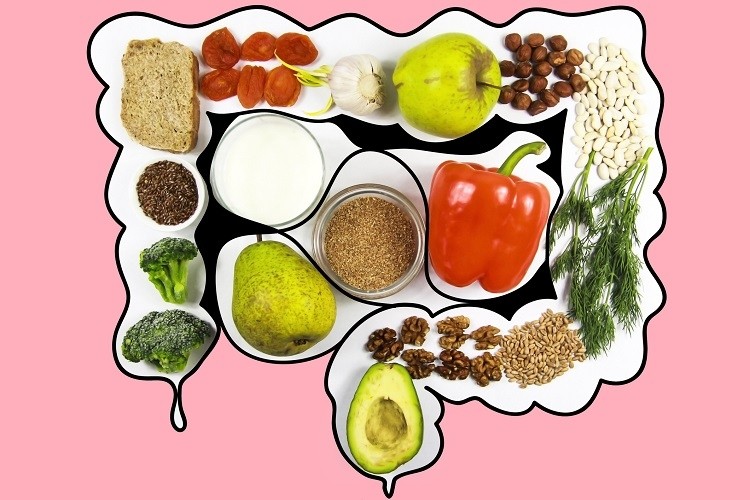Foods Good For Gut Health— Support Your Gut Bacteria for Optimal Health
It sounds scary, but we have one hundred trillion bacteria living in out guts, 400 to 500 different types weighing in at approximately four pounds. And it’s a good thing. Because you are not only what you eat, you are what you absorb, assimilate, and do not eliminate. And it’s those bacteria — probiotics — that aid in all those processes. Which is why it’s important to learn which foods are good for your gut health.
Probiotics are live bacterial microorganisms that live in the gastrointestinal tract. They fight off the toxins and pathogens that enter our digestive system through contaminated food, water, and other environmental pollutants. Studies have shown that gut bacteria can affect our mental health and mood, too.
Additionally, the digestive system contains a major component of our immune system. So the foods you eat and how well you digest them will determine, to a great extent, your overall health.
Please read about how you can support your “good” bacteria. As a bonus, we’ve included and some yummy good-for-you recipes.
The Bacteria We Can’t Live Without
Recent studies have focused on the relationship between human health and the microbial flora that colonize our gut. Among the gut bacteria, probiotics are revered as the pot of gold for offering a wide range of health benefits, including positive effects on human longevity.2
The Japanese, who own the prize for the world’s highest longevity (84 years for women, and 81 for men, and having more than 65,000 centenarians), are the prime example of people who know how to support their microbial flora. Researchers attribute the good health and longevity of the Japanese people to their eating natto, a fermented soybean like cheese that is fermented by Bacillus subtilis.
But Bacillus subtilis is just one of many probiotic bacterium. Lactobacillus, Saccharomyces, and Bifidobacterai are three of the most common probiotics.
Your gut needs both pro- and prebiotics for optimal health.2 And remember . . . it’s not just digestive health that you’re supporting with these organisms. Your immune system, longevity, and mental health also benefit from a steady diet of probiotic and prebiotic foods, and from probiotic nutritional supplements.1
Probiotic Foods Colonize the Digestive Tract with Good Bacteria
Greek yogurt
Kefir
Sauerkraut
Miso
Tempeh
Kimchi
Kombucha
Natto
Pickles
Buttermilk
Cottage cheese
Gouda, mozzarella, and cheddar cheese

Prebiotic Foods Feed the Friendly Bacteria Already in Your Gut
They support mineral absorption, vitamin utilization, and healthy blood sugar levels.
Artichokes
Jicama
Wild yams
Onions
Garlic
Asparagus
Beans and legumes
Oats
Chicory root
Jerusalem artichokes
Cabbage
Bananas, watermelon, grapefruit
Bran, barley
Almonds, pistachios, flaxseeds
Summertime probiotic recipes that feed your gut and delight your taste buds
Cottage cheese can be eaten dozens of ways. In the summer it’s great served with fruit. Any time of year, enjoy cottage cheese pancakes, either sweet or savory.
1. Sweet cottage cheese pancakes–makes 10 medium-sized pancakes
2 cups small curd cottage cheese
4 eggs
A cup flour (can use whole wheat, all purpose, or oatmeal flour, spelt, or gluten-free)
1 tsp vanilla extract
1 Tbsp. baking powder
2 Tbsp. sugar
1/4 cup coconut, avocado, or organic canola oil
Directions
Combine all ingredients in the following order: cottage cheese, eggs, vanilla extract, baking powder and flour. Mix in each time you add an ingredient.
Preheat a skillet with oil on medium heat. Fry the pancakes on each side until golden brown. Serve with syrup or jam while still hot.
2. Savory cottage cheese pancakes—makes 10 medium sized pancakes
1/3 cup chopped onion
1/4 cup chopped veggies of your choice (zucchini, pepper, corn)
1/2 tsp salt and pepper
¼ tsp dried dill or 1 tsp fresh, chopped dill
7 Tbsp. unsalted butter, melted
1 1/2 cups whole-milk cottage cheese
3 large eggs
6 tablespoons all-purpose flour
Directions
Cook onion, 1/8 teaspoon salt, and 1/8 teaspoon pepper in 2 tablespoons butter in a small heavy skillet over moderately low heat, stirring occasionally, until golden brown, about 12 minutes. Transfer to a bowl, then add cottage cheese, eggs, flour, 1/4 cup butter, remaining 1/8 teaspoon salt, and remaining 1/8 teaspoon pepper and whisk until combined. Preheat a skillet with oil on medium heat. Fry the pancakes on each side until golden brown.
3. Super easy casserole that combines both probiotic and prebiotic foods
Enchilada Bake—serves 4
14.7 oz. (1 can) of vegetarian bean chili
4 oz. of cottage cheese
8 oz. sour cream
1 cup of shredded cheddar or Monterey jack cheese
6-8 corn tortillas
Directions
Grease a small casserole dish. Tear a corn tortilla in pieces and cover bottom of dish. Spoon half of the chili over the tortillas. Spread a layer of chili. Top with a layer of cottage cheese, sour cream, and then cheddar or Monterey jack cheese. Repeat. Optional: top with sliced black olives. Bake at 350 degrees for 20 minutes or until bubbly.
——————
So the next time you go grocery shopping, include some of the above mentioned foods on your list. They’re easy to incorporate into your typical diet, and if you’re unaccustomed to eating some of the more exotic soy-based fermented foods, give it a try. You might like it, and your gut will love it!

















